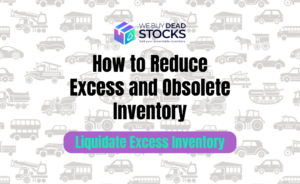Are you drowning in excess inventory? Is your storage space overflowing with products that just aren’t moving? It’s time to take control of your inventory management and free up valuable space and capital. Whether you’re a small business struggling to manage your stock or a larger enterprise burdened with surplus goods, liquidating excess inventory can be the solution you’ve been searching for. In this blog, we’ll explore the benefits of liquidation, practical strategies for clearing out excess stock, and how to maximise your returns in the process. Say goodbye to cluttered warehouses and hello to a streamlined, profitable inventory system. It’s time to liquidate your excess inventory and reclaim your space.
Assessing Your Excess Inventory 📦
In the dynamic landscape of business, maintaining optimal inventory levels is crucial for profitability and efficiency. Yet, the reality is that excess inventory can often become a burden, tying up valuable resources and space. In this article, we’ll delve into the essential steps of assessing your excess inventory to streamline your operations and unlock hidden value. From understanding the nuances of excess inventory to identifying viable close surplus buyers and even obtaining free valuation. We’ll equip you with the knowledge and strategies necessary to regain control over your inventory management processes.
- Understanding what constitutes excess inventory:
Excess inventory isn’t just about having too much stock on hand; it’s about having more inventory than you can reasonably expect to sell in a given period. Whether it’s due to overestimations in demand, changes in consumer preferences, or disruptions in the supply chain, excess inventory can accumulate quickly if left unchecked. By understanding the factors contributing to excess inventory within your business, you can begin to address the root causes and implement effective solutions.
- Methods for identifying excess inventory:
Identifying excess inventory requires a comprehensive analysis of your current stock levels, sales data, and market trends. Utilising inventory management software, conducting regular audits, and collaborating closely with your sales and procurement teams are all effective methods for pinpointing areas of excess. Additionally, leveraging data analytics and predictive modelling can provide valuable insights into future inventory requirements obtaining free valuation, allowing you to proactively manage your stock levels and mitigate the risk of overstocking.
- Analysing the costs of holding excess inventory:
While excess inventory may seem like a benign issue, the costs associated with holding surplus stock can quickly add up. From storage fees and depreciation to the opportunity cost of tying up capital that could be invested elsewhere, the financial implications of excess inventory can be significant. By conducting a thorough cost analysis, you can gain a clear understanding of the true impact of excess inventory on your bottom line and make informed decisions about how to address it.
Strategies for Liquidation 💡
Sales and Discounts
- Clearance Sales:
Offering significant discounts on excess inventory items can incentivize customers to make purchases, clearing out space and generating revenue.
- Seasonal Promotions:
Tailoring promotions to align with seasonal trends or holidays can help stimulate demand for excess inventory and facilitate faster turnover.
Wholesale Liquidation
- Selling to Discount Stores or Wholesalers:
Partnering with discount retailers or wholesalers can provide a swift outlet for excess inventory. This allows you to offload large quantities at discounted prices.
- Bulk Sales to Liquidation Companies:
Engaging with specialised liquidation companies enables you to sell excess inventory in bulk. These are often at competitive rates, freeing up space and capital.
Online Marketplaces
- Utilising E-commerce Platforms:
Leveraging e-commerce platforms offers a global reach and accessibility to a vast customer base, facilitating the sale of excess inventory directly to consumers.
- Auction Sites and Online Marketplaces:
Participating in online auctions or listing excess inventory on popular marketplaces can attract close surplus buyers seeking discounted products, driving sales and clearing inventory.
Donation and Charitable Contributions
- Tax Benefits of Donating Excess Inventory:
Donating excess inventory to qualified non-profit organisations not only allows you to contribute to worthy causes but also offers potential tax advantages, providing a win-win scenario.
- Contributing to Non-profit Organisations:
Partnering with charitable organisations enables you to make a positive impact while freeing up storage space and potentially benefiting from tax deductions.
Implementing the Liquidation Plan 💯
Now that you’ve identified your excess inventory and explored various liquidation strategies, it’s time to put your plan into action. Implementing a well-defined liquidation plan is essential for maximising returns, connecting with close surplus buyers, and reclaiming valuable space within your organisation. Let’s delve into the key steps involved in executing your liquidation strategy effectively.
Setting Clear Goals and Objectives
- Define specific goals and objectives for your liquidation efforts, whether it’s to reduce inventory levels, generate revenue, or free up storage space.
- Establish measurable targets and benchmarks to track progress and evaluate the success of your liquidation plan.
Allocating Resources for Liquidation Efforts
- Allocate adequate resources, including manpower, financial resources, and technology, to support your liquidation initiatives.
- Consider outsourcing certain aspects of the liquidation process, such as logistics or marketing, to specialised service providers to streamline operations and maximise efficiency.
Establishing Timelines and Deadlines
- Develop a realistic timeline for executing your liquidation plan, taking into account factors such as the size of your excess inventory, the chosen liquidation channels, and market conditions.
- Set deadlines for key milestones and activities to ensure timely execution and minimise delays in the liquidation process.
Communicating with Stakeholders
- Keep stakeholders, including employees, suppliers, customers, and investors, informed about your liquidation plan and its potential impact on various aspects of the business.
- Communicate transparently about the reasons for liquidating excess inventory, the steps being taken, and the expected outcomes to maintain trust and mitigate any potential concerns.
Conclusion
In the fast-paced world of business, effective inventory management is essential for staying competitive and profitable. Excess inventory can be a major obstacle to success. But with the right strategies in place, you can turn it from a burden into an opportunity. By assessing your excess inventory, implementing targeted liquidation strategies, and communicating openly with stakeholders, you can reclaim valuable space and resources for your business. So don’t let excess inventory weigh you down any longer. It’s time to take action and set your business up for long-term success.





